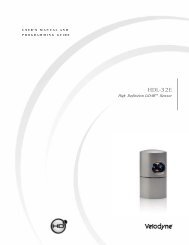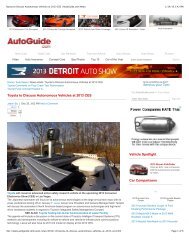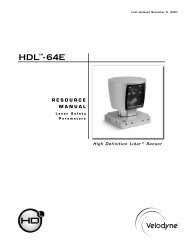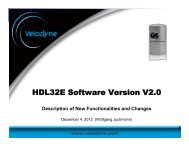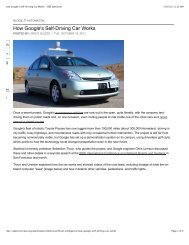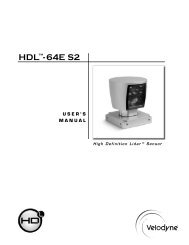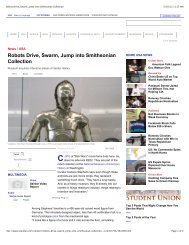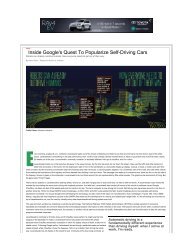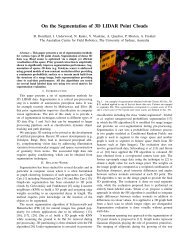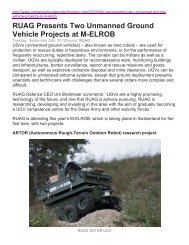Driverless Vehicles Make Inroads in Military - Velodyne Lidar
Driverless Vehicles Make Inroads in Military - Velodyne Lidar
Driverless Vehicles Make Inroads in Military - Velodyne Lidar
You also want an ePaper? Increase the reach of your titles
YUMPU automatically turns print PDFs into web optimized ePapers that Google loves.
Essential<br />
Components<br />
Someday, Will <strong>Driverless</strong><br />
Car Tech Kill Traffic Lights<br />
A University of Missouri-Kansas City professor believes<br />
that one day, software that automates vehicle movement<br />
at <strong>in</strong>tersections could do away with traffic lights.<br />
“The idea is not a driverless car. <strong>Driverless</strong> cars take away<br />
the fun of driv<strong>in</strong>g. The ma<strong>in</strong> objective is to improve traffic<br />
flow <strong>in</strong>side the city and do away with the traffic lights,<br />
because they are expensive to ma<strong>in</strong>ta<strong>in</strong>,” Vijay Kumar<br />
told the University News, UM-CK’s <strong>in</strong>dependent student<br />
newspaper.<br />
Currently, Kumar is study<strong>in</strong>g the “ambiguity effect”<br />
where drivers make decisions despite a lack of <strong>in</strong>formation.<br />
Ambiguous and delayed decisions can result <strong>in</strong> an<br />
accident. However, a number of newer model cars use<br />
software to enable better driver decision mak<strong>in</strong>g through<br />
technologies like lane keep<strong>in</strong>g.<br />
Kumar is zero<strong>in</strong>g <strong>in</strong> on elim<strong>in</strong>at<strong>in</strong>g traffic lights from<br />
<strong>in</strong>tersections or mak<strong>in</strong>g them more effective. To do this,<br />
cars will have to communicate with each other and the<br />
traffic lights so they can <strong>in</strong>telligently direct traffic.<br />
Kumar predicts with limited fund<strong>in</strong>g it would take two<br />
years for such a system to be on the market.<br />
UK Drivers Skittish on <strong>Driverless</strong> Cars<br />
U.K.-based <strong>in</strong>surance firm Be Wiser Insurance found<br />
<strong>in</strong> a poll that more than two-thirds of British motorists<br />
are uncomfortable with the notion of shar<strong>in</strong>g the road<br />
with driverless cars.<br />
Sixty-eight percent of poll takers reported be<strong>in</strong>g uncomfortable<br />
while 32 percent favored it, cit<strong>in</strong>g human<br />
judgment flaws that lead to accidents.<br />
“Reduc<strong>in</strong>g the potential for human error could make<br />
for a safer driv<strong>in</strong>g experience — especially when it<br />
comes to those little bumps and scrapes which occur<br />
when momentary distraction is to blame. A computer<br />
rarely loses concentration,” says Mark Bower-Dyke,<br />
chairman of Be Wiser Insurance.<br />
Concerns among those that said they were uncomfortable<br />
driv<strong>in</strong>g near self-driv<strong>in</strong>g vehicles <strong>in</strong>cluded who<br />
would be responsible <strong>in</strong> an accident and whether driverless<br />
cars could be trusted more than a standard computer.<br />
“Automated park<strong>in</strong>g is already be<strong>in</strong>g hailed as a boon<br />
to both drivers and <strong>in</strong>surers as it reduces the number<br />
of park<strong>in</strong>g related claims,” Bower-Dyke says. “We hope<br />
that driverless cars will be the logical end of safer driv<strong>in</strong>g,<br />
especially for those who don’t like or enjoy driv<strong>in</strong>g<br />
at all.”<br />
Many respondents to the poll also keyed <strong>in</strong> on one gray<br />
area that would exist with driverless car passengers —<br />
the ability to dr<strong>in</strong>k alcohol before gett<strong>in</strong>g <strong>in</strong> the car.<br />
“<strong>Driverless</strong> cars could provide real safety advantages<br />
when there are enough of them on the road,” says<br />
Bower-Dyke. “It’s not all about hav<strong>in</strong>g a robot chauffeur<br />
to drive you back from the pub.”<br />
Advanced Navigation Releases<br />
Triple-Tech Spatial Fog<br />
Australia’s Advanced Navigation has released Spatial<br />
Fog, a spoof-proof enhanced GPS system that can also<br />
operate <strong>in</strong> areas where GPS is weak or nonexistent.<br />
Spatial Fog comb<strong>in</strong>es a GPS receiver with KVH Industries’<br />
1750 <strong>in</strong>ertial measurement unit, allow<strong>in</strong>g<br />
the system to fall back on <strong>in</strong>ertial navigation if GPS<br />
isn’t available. However, the system also uses receiver<br />
autonomous <strong>in</strong>tegrity monitor<strong>in</strong>g (RAIM) to prevent<br />
spoof<strong>in</strong>g, which could be a problem if someone tries to<br />
electronically hijack a self-driv<strong>in</strong>g car.<br />
“RAIM works by analyz<strong>in</strong>g<br />
multiple satellite<br />
signals and develop<strong>in</strong>g<br />
a statistical model<br />
of the observed versus<br />
expected signals,” the<br />
company says. “From<br />
this model it is able to<br />
determ<strong>in</strong>e if there is a<br />
fault with the signals it<br />
is receiv<strong>in</strong>g.”<br />
Comb<strong>in</strong>g all three systems<br />
makes the system<br />
good for safety-conscious<br />
autonomous vehicles,<br />
the company says.<br />
Advanced Navigation’s Spatial Fog.<br />
Photo courtesy the company.<br />
MISSION CRITICAL • May 2013 5




